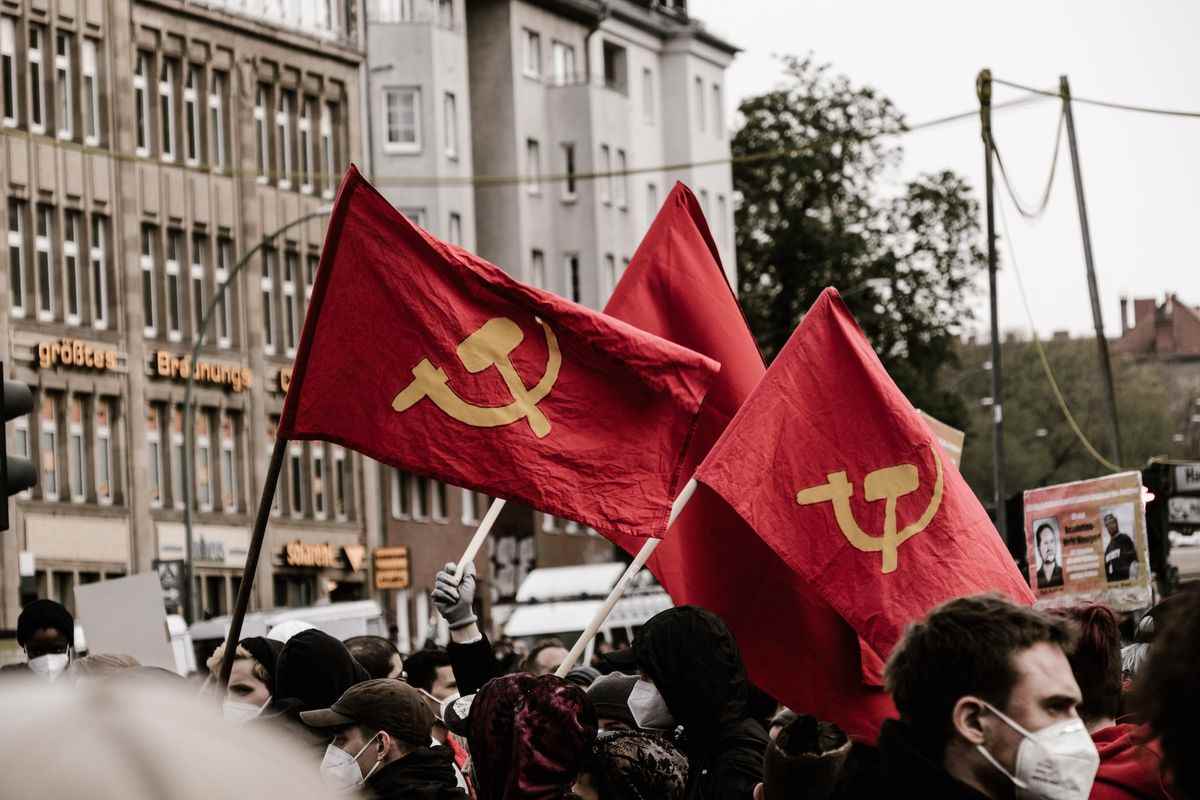Have you ever wondered why the color red is so closely associated with communism and socialism? It’s not just a random choice of color — there’s a historical and symbolic reason behind it.
Let’s dive into the fascinating story of how red became the color of these political ideologies.
The Vibrant History Behind Red: From Phrygian Caps to Communist Ideals
The tale of why red became the color of communism and socialism is a journey spanning over 2,500 years and spanning the globe. This vibrant narrative connects the assassination of Julius Caesar, the French Revolution, and even a seemingly small detail on the official seal of the US Senate.
Our story has its origin in a region of Turkey known as Phrygia, where over two millennia ago, people donned a peculiar conical hat with a forward-bent peak. This distinctive headwear, known as a “Phrygian cap,” found its place across the ancient world — from Iran to the Balkans.

Even mythical figures like Orpheus, who ventured into the underworld, often sported one of these caps.
A Color with a Past
In the annals of Ancient Rome, freed slaves received a “pileus” as a symbol of their liberation, resembling but distinct from the Phrygian cap. This cone-shaped hat symbolized their newfound freedom.
However, after Julius Caesar’s assassination, those who sought to liberate Rome adopted the pileus as a powerful emblem of Roman people’s freedom, often displaying it atop spears as they paraded through the city.
As history unfolded through the Renaissance and the Enlightenment, drawing inspiration from the political ideals of Ancient Rome and Greece, depictions of this “freedom hat” emerged in art across Europe.
Libertas, the goddess of liberty, was frequently depicted donning one, while the Dutch “maiden of freedom” wielded it on the tip of a spear.
The goddess Libertas is also depicted on the Great Seal of France, created in 1848. This is the image that later influenced French sculptor Frédéric Auguste Bartholdi in the creation of his now-famous Statue of Liberty Enlightening the World.
Over time, these two hats, the Phrygian cap, and the Roman pileus, fused into one symbol with the appearance of the former and the meaning of the latter.
Yet, in the ancient world, this symbol bore no specific color. So, why did it evolve to become predominantly red?
The Middle Ages provide a clue. A red flag raised above a besieged city traditionally meant “no surrender.”
This association stemmed from the profound connection between the color red and human blood – a connection tied to themes of death, courage, and sacrifice. Given this connection to resistance, it made sense for the Phrygian cap to adopt the color red, signifying a struggle for liberty.
The American Revolution, steeped in the political ideals of Rome and Greece, adopted the red Phrygian cap as a symbol of liberty. Drawing inspiration from the assassination of Julius Caesar, it found its way onto the seal of the US Senate.
The ‘Red’ of the French Revolution
Now, enter the French Revolution, likewise inspired by the Roman Republic. Revolutionaries donned the red Phrygian cap, making it synonymous with the revolution itself. Red consequently became the color of the new government.
Even Marianne, the embodiment of the French Republic, wore a red Phrygian cap.
Red was no longer just a symbol of sacrifice and resistance; it embodied freedom, republicanism, and radical political change.
In the June Rebellion of 1830, red flags flew on barricades. Following the French Revolution of 1848, there was a proposal to make the French flag entirely red, although they eventually retained the tricolor. However, the color red had become indelibly linked with revolution by this point.
Across the English Channel, during the Merthyr Rising of 1831 in Wales, a red flag was hoisted, connecting the color not only to the revolution in general but also to a workers’ revolution.
In Britain, even before the publication of the Communist Manifesto, the link was forged between the color red and, specifically, socialism, leading to its adoption by the Labour Party.
In 1871, the red flag was officially used by a political authority for the first time during the short-lived Paris Commune, cementing the enduring association between the color red and left-wing politics.
Fast forward to the Russian Revolutions of 1917, where red flags reminiscent of the Paris Commune were raised by the Communists.
Thus, when the USSR adopted its flag in 1922, it was only natural to make it red, embellished with the iconic hammer and sickle. From that moment onward, and to this day, red has become the global symbol of communism.
The evolution of red as the color of communism and socialism is a colorful and intricate journey through history, rich with symbolism and meaning. From the ancient Phrygian caps to the revolutionary movements that spanned continents, red has become a vibrant emblem of ideals such as freedom, republicanism, and radical political change.
First, we need to understand that colors have meaning. They can carry deep cultural and historical significance. Red, in particular, has always been a color associated with strong emotions, power, and revolution.
The Russian Revolution of 1917
The modern roots of the red association with communism can be traced back to the Russian Revolution of 1917. During this pivotal moment in history, the Bolsheviks, led by Vladimir Lenin, overthrew the existing government. Their symbol was a red flag. But why red?
Apart from its ancient roots in history, Red was also chosen because it represents some of the core values of communism and socialism. It’s a color that symbolizes the struggle of the working class, the fight for equality, and the idea of a society where resources are shared more equitably.
The Blood of the Workers
The choice of red is also a nod to the workers’ struggle. Red represents the blood shed by the working class in their fight for better working conditions and fair wages.
It’s a stark reminder of the sacrifices made in the pursuit of a more just society.
A Global Symbol
As communism and socialism spread to other parts of the world, the use of red as a symbol became more widespread.
The color represented a global movement aimed at challenging the status quo and creating a world where wealth and power were more evenly distributed.
Unity and Revolution
Red is also a color that can unite people. It’s bold and attention-grabbing, making it a powerful symbol for rallying supporters and sparking revolutions. When people see the color red, they often think of change and social justice.
The color red’s association with communism and socialism is not a random choice, that many people may believe, but a carefully considered symbol.
It embodies the core values of these ideologies — equality, the struggle of the working class, and the hope for a better future.



